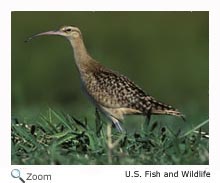Bristle-thighed curlew - Numenius tahitiensis |
||||||||||
Description
Range
Habitat
During breeding season, the bristle-thighed curlew is found on hilly inland tundra in Alaska. In winter, it is found on sandy South Pacific island beaches. |
DietThe bristle-thighed curlew eats crustaceans, small fish, bird eggs, and snails. On the tundra during breeding season, it eats insects, seeds, and berries. The bristle-thighed curlew sometimes smashes large food items like crabs against the ground or a flat rock to open them up. It takes the crab in its bill, raises its head up, and then brings its head down and slams the crab against a flat rock or the ground. The bristle-thighed curlew also uses rocks or coral to open eggs. It takes a piece of coral or a rock in its bill and flings it into a bird egg again and again until the egg breaks open. It then uses its long, pointed bill to poke into the egg and open it up. It is one of only a few bird species that are known to use a tool to get food! Life Cycle
BehaviorScientists have known about the bristle-thighed curlew since the mid-1700s, but they didn't know about their breeding grounds in Alaska until 1948! |
|||||||||
| Audio Credit: xeno-canto.org Allen Creek |
||||||||||


 The bristle-thighed curlew breeds in western Alaska. It winters in Hawaii and other South Pacific Islands including
Samoa, Micronesia, Fiji, and French Polynesia.
The bristle-thighed curlew breeds in western Alaska. It winters in Hawaii and other South Pacific Islands including
Samoa, Micronesia, Fiji, and French Polynesia.